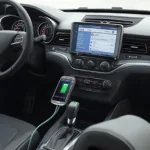Monitoring your car’s engine speed, or RPM (revolutions per minute), is crucial for performance diagnostics. OBD2, the onboard diagnostics system in most modern vehicles, allows access to this vital data, opening up a world of understanding about your engine’s health and efficiency. This article dives deep into the world of rpm obd2, exploring how it works, why it’s important, and how you can utilize this data for a smoother, more informed driving experience.
Understanding your car’s RPM through the OBD2 system is more than just reading a number; it’s about tapping into the heart of your vehicle’s performance. From diagnosing potential issues to maximizing fuel efficiency, the insights gleaned from rpm obd2 data are invaluable for any driver or mechanic. This article will guide you through the complexities of RPM in OBD2, providing you with the knowledge you need to make the most of this powerful diagnostic tool.
Decoding RPM through OBD2
The OBD2 system acts as a bridge between your car’s computer and the outside world. It allows access to a plethora of data points, including engine speed, or RPM. This information is transmitted through standardized protocols, making it accessible via OBD2 scanners. By using a scanner, you can observe your engine’s RPM in real-time, enabling you to identify unusual fluctuations or patterns that could indicate underlying problems.
How OBD2 Retrieves RPM Data
The Engine Control Unit (ECU), the brain of your car’s engine, constantly monitors and adjusts various parameters, including RPM. This data is then transmitted via the OBD2 system using a specific Parameter ID (PID). When you connect an OBD2 scanner, it requests this PID, and the ECU responds with the current RPM value. This communication happens continuously, allowing you to observe live changes in engine speed.
Why RPM Data Matters
Knowing your engine’s RPM is vital for various reasons. For instance, it can help identify issues like misfires, rough idling, or a failing throttle position sensor. Monitoring RPM also allows you to optimize your driving habits for better fuel economy. By understanding the relationship between RPM and fuel consumption, you can learn to shift gears more efficiently and avoid unnecessary revving.
RPM and Diagnostics: Identifying Potential Problems
Analyzing RPM data can often pinpoint the source of engine problems. Consistent fluctuations at idle, for example, might suggest a vacuum leak or a faulty sensor. obd2 2112 offers a comprehensive insight into such diagnostic codes. A sudden drop in RPM could indicate a problem with the fuel system or ignition. By paying close attention to these patterns, you can diagnose problems early and prevent more significant damage. obd2 rpm meter offers a detailed exploration of this subject.
RPM and Fuel Efficiency: Driving Smarter
RPM plays a critical role in fuel consumption. Higher RPM generally means higher fuel consumption. By understanding your engine’s optimal RPM range, you can shift gears at the right time and avoid wasting fuel. reading rpm data from obd2 python provides a technical deep dive into how you can access and analyze this data using programming. This not only saves you money but also reduces your carbon footprint.
Using OBD2 Scanners to Monitor RPM
Numerous OBD2 scanners are available on the market, ranging from simple code readers to advanced diagnostic tools. Choose a scanner that suits your needs and budget. arduino obd2 rpm provides information on building your own RPM monitoring system using an Arduino. Once connected, the scanner displays real-time RPM data, allowing you to monitor engine performance.
Conclusion
Understanding rpm obd2 empowers you to take control of your vehicle’s health and performance. From diagnosing potential issues to optimizing fuel efficiency, the insights gleaned from this data are invaluable. By utilizing the information provided in this article, you can unlock the full potential of your OBD2 system and ensure a smoother, more informed driving experience.
FAQ
-
What is RPM?
RPM stands for revolutions per minute and measures how fast your engine’s crankshaft is rotating. -
How do I access RPM data through OBD2?
You’ll need an OBD2 scanner, which plugs into your car’s OBD2 port and reads the data from the ECU. -
Why is monitoring RPM important?
It helps in diagnosing engine issues and optimizing fuel efficiency. -
Can high RPM damage my engine?
Sustained high RPM can lead to increased wear and tear on engine components. -
What is a good RPM range for fuel efficiency?
It varies by vehicle, but generally, lower RPMs contribute to better fuel economy. -
How can I use RPM data to improve my driving?
By shifting gears at the optimal RPM, you can minimize fuel consumption. -
Where can I learn more about obd2 codes 2110?
This specific code relates to the throttle actuator control system. You can find more information on specialized OBD2 code websites and forums.
Need help with your car diagnostics? Contact us via WhatsApp: +1(641)206-8880, Email: [email protected] or visit us at 789 Elm Street, San Francisco, CA 94102, USA. Our 24/7 customer support team is ready to assist you.


